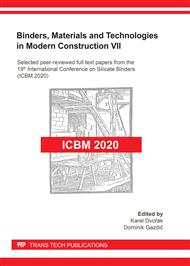[1]
C. W. Tallentire, B. Steubing, The environmental benefits of improving packaging waste collection in Europe, Waste Management, Volume 103, 15 February 2020, Pages 426-436. DOI: https://doi.org/10.1016/j.wasman.2019.12.045.
DOI: 10.1016/j.wasman.2019.12.045
Google Scholar
[2]
C. Callao, M. Martinez,Nuñez M. P. Latorre, European Countries: Does common legislation guarantee better hazardous waste performance for European Union member states?, Waste Management, Volume 84, 1 February 2019, Pages 147-157". DOI: https://doi.org/10.1016/j.wasman.2018.11.014.
DOI: 10.1016/j.wasman.2018.11.014
Google Scholar
[3]
G. van Capelleveen, C. Amrit, H. Zijm, D. M. Yazan, A. Abdi, Toward building recommender systems for the circular economy: Exploring the perils of the European Waste Catalogue, Journal of Environmental Management, Volume 277, 1 January 2021, 111430. DOI: https://doi.org/10.1016/j.jenvman.2020.111430.
DOI: 10.1016/j.jenvman.2020.111430
Google Scholar
[4]
A. Minelgaitė, G. Liobikienė, Waste problem in European Union and its influence on waste management behaviours, Science of The Total Environment, Volume 667, 1 June 2019, Pages 86-93. DOI: https://doi.org/10.1016/j.scitotenv.2019.02.313.
DOI: 10.1016/j.scitotenv.2019.02.313
Google Scholar
[5]
S. A.Bassi, T. H. Christensen, A. Damgaard, Environmental performance of household waste management in Europe - An example of 7 countries, Waste Management, Volume 69, November 2017, Pages 545-557. DOI: https://doi.org/10.1016/j.wasman.2017.07.042.
DOI: 10.1016/j.wasman.2017.07.042
Google Scholar
[6]
J. L. G. Martos, D. Styles, H. Schoenberger, B. Z. Lahl, Construction and demolition waste best management practice in Europe, Resources, Conservation and Recycling, Volume 136, September 2018, Pages 166-178. DOI: https://doi.org/10.1016/j.resconrec.2018.04.016.
DOI: 10.1016/j.resconrec.2018.04.016
Google Scholar
[7]
C. Yaman, Investigation of greenhouse gas emissions and energy recovery potential from municipal solid waste management practices, Environmental Development, Volume 33, March 2020, 100484. DOI: https://doi.org/10.1016/j.envdev.2019.100484.
DOI: 10.1016/j.envdev.2019.100484
Google Scholar
[8]
P. S. M. Devadoss, P. Agamuthu, S. B. Mehran, S. S.H. Fauziah, Implications of municipal solid waste management on greenhouse gas emissions in Malaysia and the way forward". Waste Management, Volume 119, 1 January 2021, Pages 135-144. DOI: https://doi.org/10.1016/j.wasman.2020.09.038.
DOI: 10.1016/j.wasman.2020.09.038
Google Scholar
[9]
O. A. Hisseine, A. T. Hamou, Nanocellulose for ecological nanoengineered strain-hardening cementitious composites incorporating high-volume ground-glass pozzolans, Cement and Concrete Composites, Volume 112, September 2020, 103662. DOI: https://doi.org/10.1016/j.cemconcomp.2020.103662.
DOI: 10.1016/j.cemconcomp.2020.103662
Google Scholar
[10]
R. Ji, Y. Zheng, Z. Zou, Z. Chen, S. Wei, X. Jin, M. Zhang, Utilization of mineral wool waste and waste glass for synthesis of foam glass at low temperature, Construction and Building Materials, Volume 215, 10 August 2019, Pages 623-632. DOI: https://doi.org/10.1016/j.conbuildmat.2019.04.226.
DOI: 10.1016/j.conbuildmat.2019.04.226
Google Scholar
[11]
S. Yang, J.X. Lu, C. S. Poon, Recycling of waste glass in dry-mixed concrete blocks: Evaluation of alkali-silica reaction (ASR) by accelerated laboratory tests and long-term field monitoring, Construction and Building Materials, Volume 262, 30 November 2020, 120865. DOI: https://doi.org/10.1016/j.conbuildmat.2020.120865.
DOI: 10.1016/j.conbuildmat.2020.120865
Google Scholar
[12]
Methods of testing cement - Part 6: Determination of fineness EN 196-6:(2018).
Google Scholar
[13]
Adauto José Miranda de Lima, Setsuo Iwakiri, Rosilani Trianoski, Determination of the physical and mechanical properties of wood-cement boards produced with Pinus spp and pozzolans waste, Maderas, Cienc. tecnol. vol.22 no.4 Concepción oct. 2020. DOI: http://dx.doi.org/10.4067/S0718-221X2020005000411.
DOI: 10.4067/s0718-221x2020005000411
Google Scholar
[14]
Methods of testing cement - Part 9: Heat of hydration - Semi-adiabatic method EN 196-9:(2010).
Google Scholar
[15]
EN 196-1:2016. Methods of testing cement. Determination of strength.
Google Scholar


